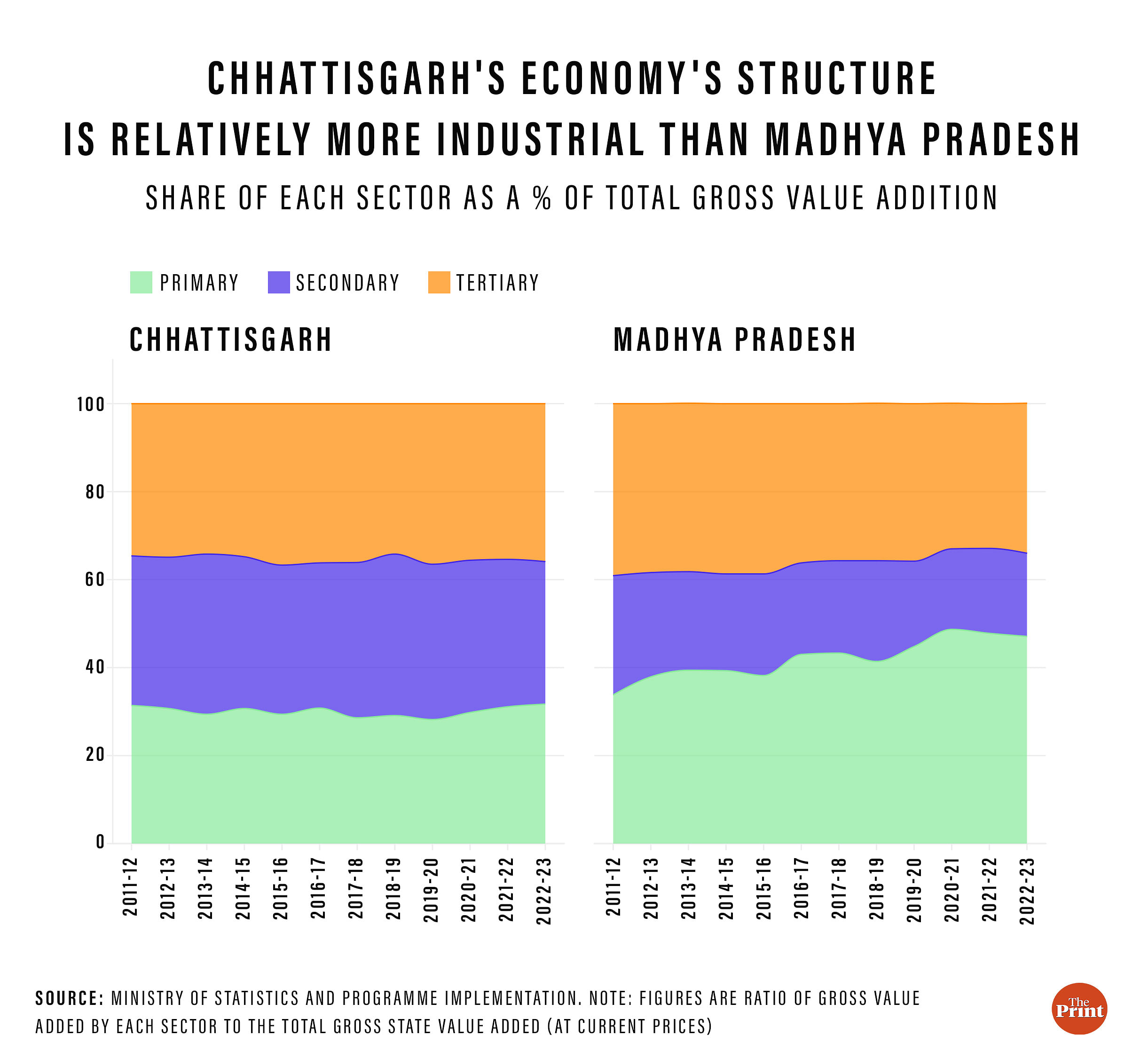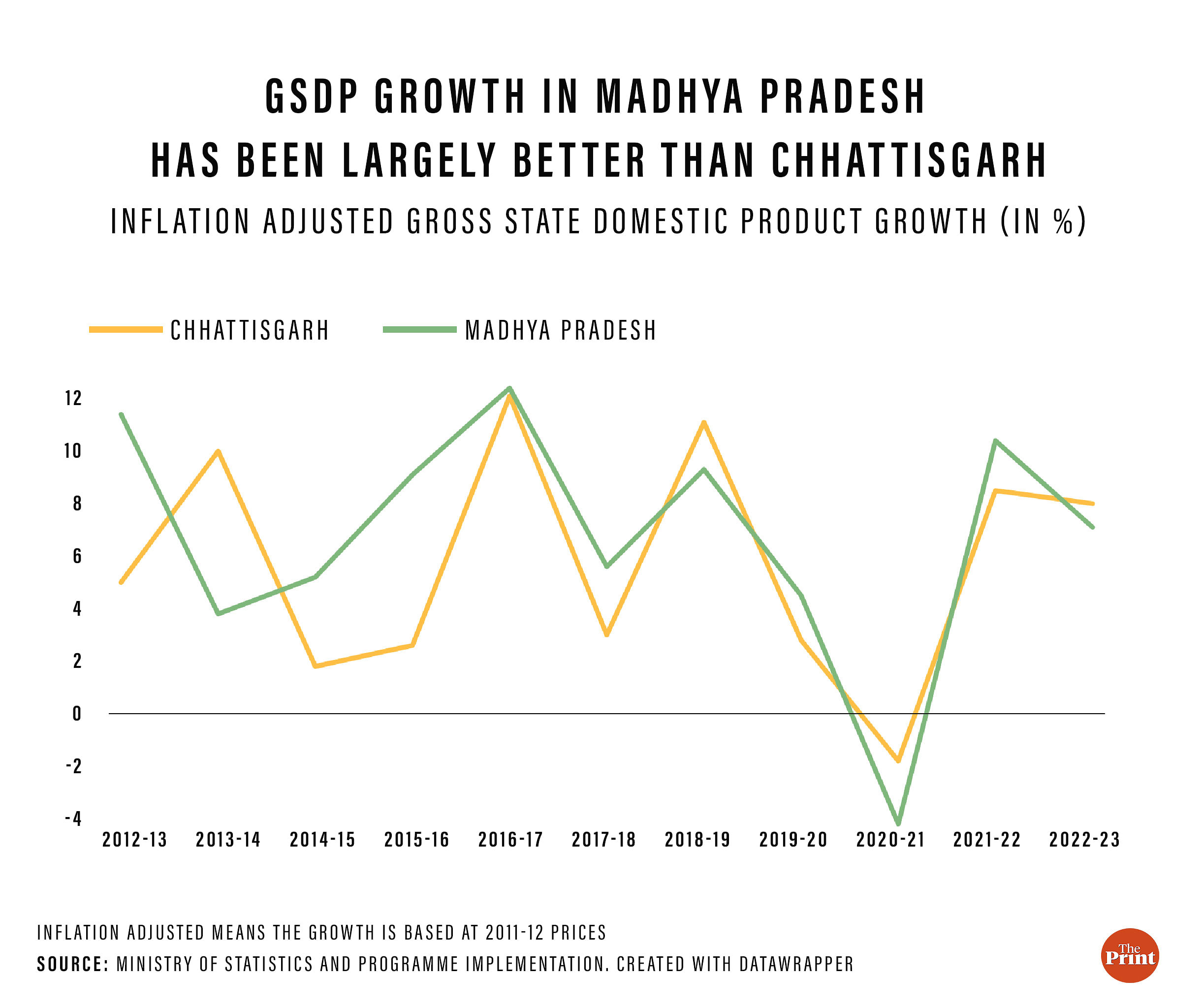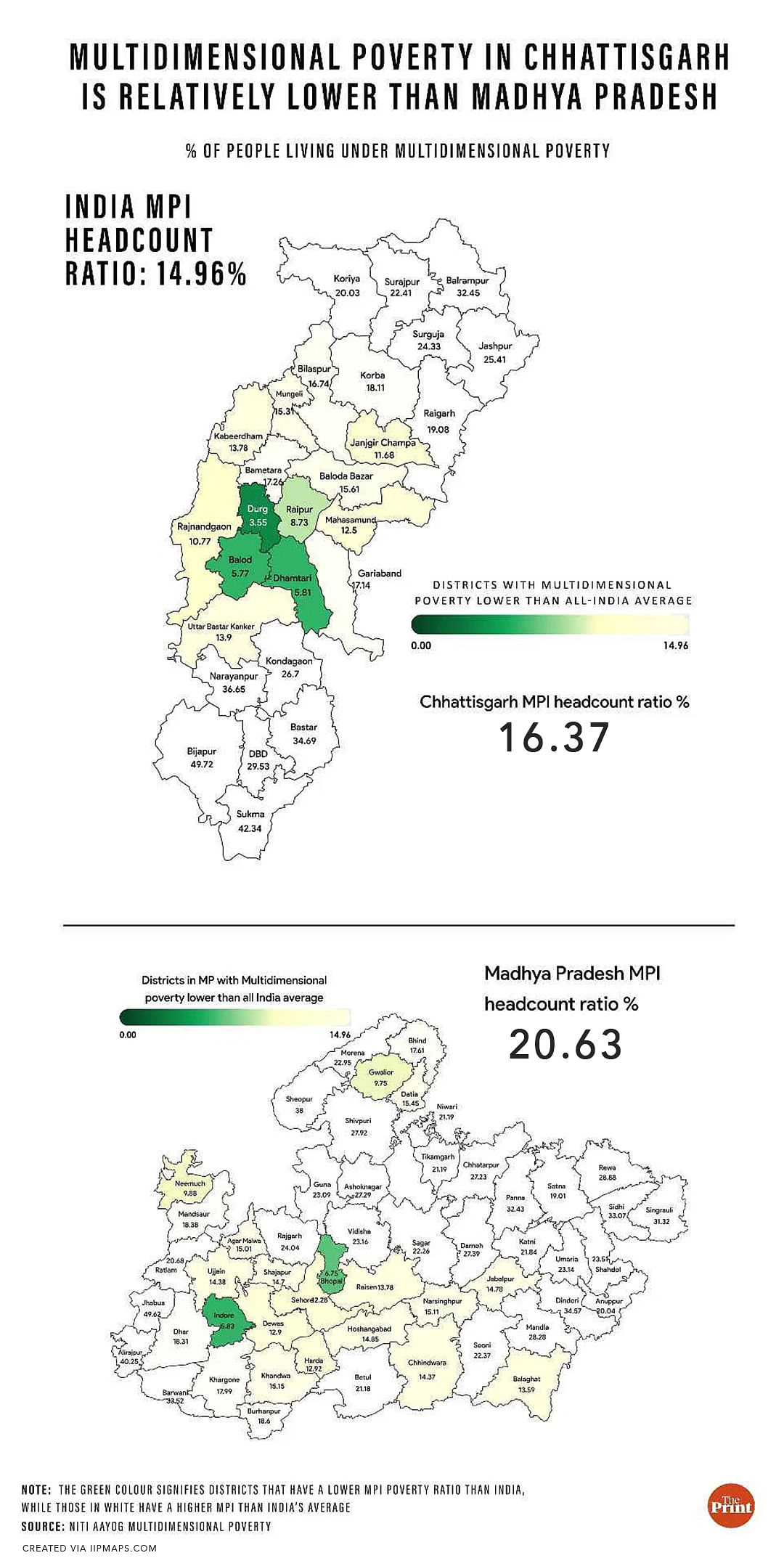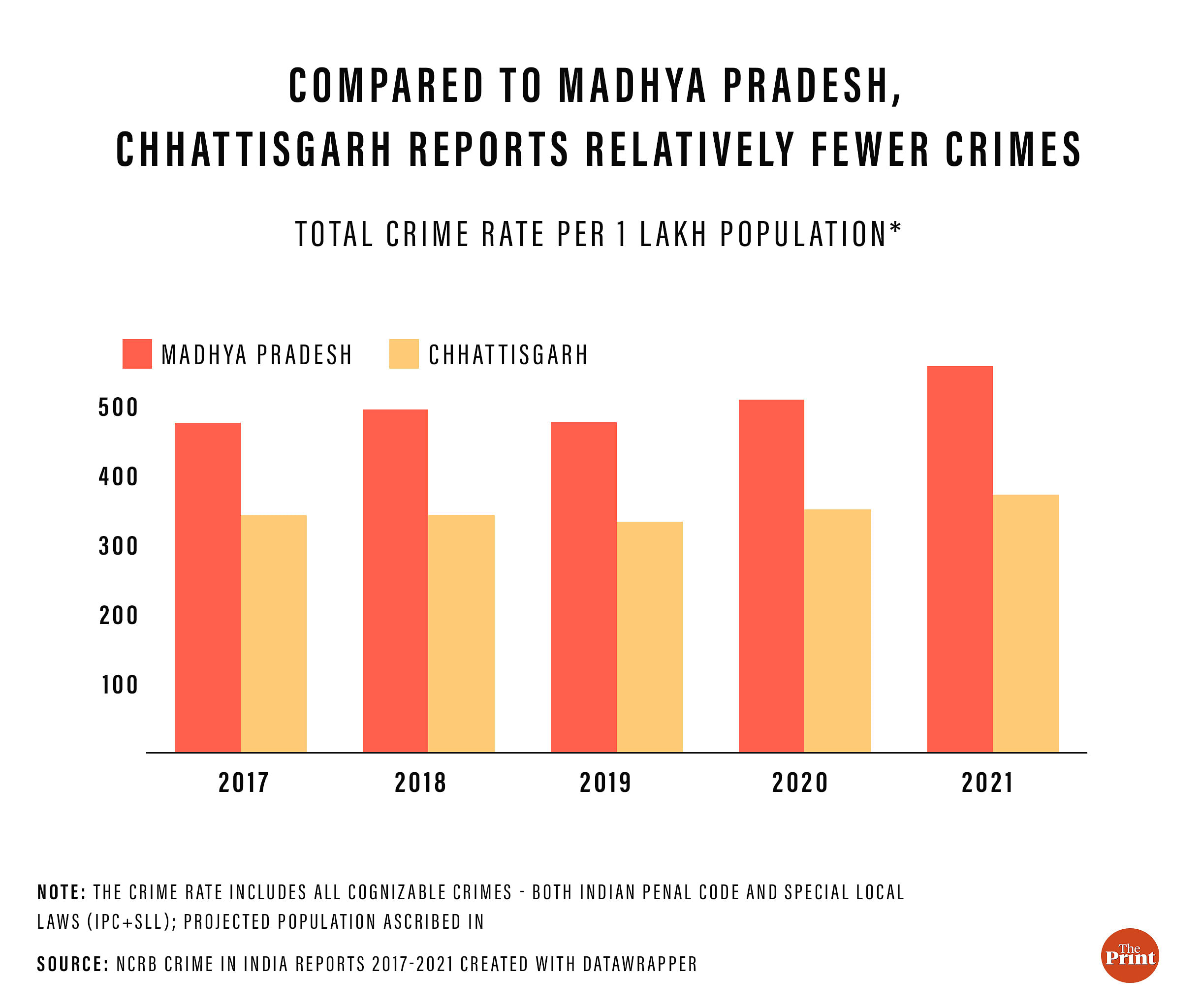Rome: Despite a higher GDP growth rate, Madhya Pradesh seems to have been surpassed on several parameters by Chhattisgarh, which was carved out of the former in 2000.
From the NITI Aayog’s Multidimensional Poverty Index to the crime rate, Chhattisgarh is recording a much better performance than its parent state, an analysis by ThePrint has found.
Experts say one key difference in the functioning of Chhattisgarh and MP is that the parent state has grown more dependent on agriculture, contrary to the national trend.
Agriculture, on average, accounts for 30 percent of Chhattisgarh’s total Gross Value Added GVA) by economic activities, against 43 percent for Madhya Pradesh.
While the contribution of services is nearly the same — 35.5 percent for Chhattisgarh and 35.6 percent for MP — it is the industrial sector where Chhattisgarh stands out.

In Chhattisgarh, between 2011-12 and 2022-23, industry accounted for about 34.4 percent of the GVA by the total economic activities, compared to 20 percent in MP.
Both states are headed for polls this month, with the first phase of polling in Chhattisgarh currently underway.
Also Read: Indian states with less than 10% multidimensional poverty doubled in 5 yrs, says NITI Aayog report
Slow and steady — Chhattisgarh grows
Between 2011-12 and 2022-23, the GSDP or state GDP of Madhya Pradesh grew by 6.7 percent per annum on average (compound annual growth rate or CAGR). The growth was 5.6 percent for Chhattisgarh in the same period.

Through the intervening years, the trend alternated, with Chhattisgarh reporting a higher growth rate in financial years 2014, 2019, 2021, and 2023.
However, the CAGR balances out such differences and provides a reliable assessment for the long-term picture.
The poverty comparison
Despite the lower GSDP growth rate, Chhattisgarh appears to be doing better in terms of development that targets deprivation.
According to the 2023 edition of the NITI Aayog Multidimensional Poverty Index (MPI), which seeks to assess deprivation on 11 parameters beyond the income yardstick, 16.37 percent of Chhattisgarh’s population was found to be deprived, compared to 20.63 percent for MP.
This means that for every 100 people in each state, one would find five fewer “deprived” people in Chhattisgarh than in Madhya Pradesh.
The report is based on statistics from the National Family Health Survey-5, which covers the period from 2019 to 2021.
District-wise data from the federal thinktank’s report shows that 33 percent of Chhattisgarh’s 27 districts performed better than the national average — 14.96 percent — on the MPI. The figure for MP was 27 percent of 51 districts (it took Niwari and Tikamgarh, from which it was carved out, as one district, MP has 52 districts).

Out of the 11 indicators through which the MPI is calculated, Chhattisgarh reported lower poverty on seven. Among the four indicators where Madhya Pradesh was found to have done better, the difference was less than 1 percentage point in three — nutrition, child and adolescent mortality, and housing.
However, on cooking fuel deprivation, the figure was 60.88 percent for MP and 66.85 percent for Chhattisgarh — which means that, for every 100 people in each state, MP had six fewer people who are deprived of access to cooking gas.
Meanwhile, among the parameters where Chhattisgarh was ahead, the difference was higher than one percentage point in all but electricity.
The largest difference was in the sanitation and drinking water category.
In Chhattisgarh, less than one in ten families (8.37 percent) were found to be deprived on the drinking water parameter — which assessed access to safe drinking water at home or within a 30-minute walk — against over one in five (21.73 percent) in MP.
In sanitation deprivation — measured as a percent of families not having a toilet at home, or sharing a toilet with other families — Chhattisgarh’s score was 23.15 percent, compared to 35 percent for MP. The national average for sanitation deprivation was measured at 30.13 percent.
Crime
According to National Crime Records Bureau (NCRB) data assessed by ThePrint, between 2017 and 2021 (five years), Madhya Pradesh reported 505 crimes (both IPC and Special Local Laws) for every one lakh people, against 350 in Chhattisgarh.
However, it needs to be noted that while better policing and reporting infrastructure can influence NCRB numbers, underreporting — which cannot be measured — is a possibility in both the states.

Understanding the trend
Speaking to ThePrint, Santosh Mehrotra, a professor in the economics department of Delhi’s Jawaharlal Nehru University, said Chhattisgarh’s growth is a matter for celebration.
“Considering that Chhattisgarh has been affected intensely by the Naxal movement and that it has a high share of tribal population, the trajectory of the state’s economic development is worth celebrating even if it comes at a slower pace,” he noted.
“While the veracity of multidimensional poverty figures is questionable, the possibility of Chhattisgarh being more developed because of the changing structure of its economy — that is moving above agriculture — cannot be ruled out,” he added.
Mehrotra said agriculture “has great power to alleviate poverty in the short run”.
“But in the long run, one has to pull out labourers from farms to factories for sustained growth — clearly not visible in Madhya Pradesh, where against the national trend, agriculture is driving the growth,” he added.
“Chhattisgarh was at the forefront of mining, now it is generating surplus electricity — pushing for more industrial growth,” he said.
(Edited by Sunanda Ranjan)






